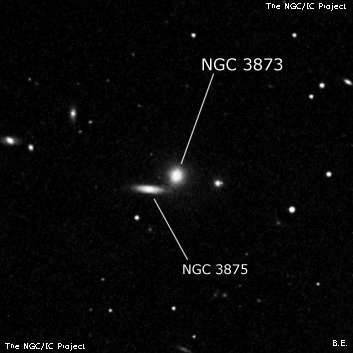
William Herschel discovered NGC 3873 = H III-387 on 27 Apr 1785 (sweep 403) and noted "vF, vS, R." His position matches the double system NGC 3873/3875 so III-387 could apply to either component. But it's reasonable to assume he picked up NGC 3873, which is slightly brighter and larger visually.
When Heinrich d'Arrest observed III-387 on 8 May 1864, he discovered it was double and measured both components. He applied III-387 to the northwest component and wrote "Double Nebula, seen [by WH] as single in 1785. Estimated distance = 52", PA = 119°. The north-preceding [NGC 3873] is a little brighter and the view is the fainter [NGC 3873] is extremely difficult. Both are only 2'." But when Dreyer added d'Arrest's "nova" to the GC Supplement (5582), he mistakenly wrote "III-387 sf", instead of "III-387 np". Assuming III-387 applies to NGC 3873, then d'Arrest should be credited with the discovery of NGC 3875.
300/350mm - 13.1" (2/25/84): faint, small, round, bright core, close pair with NGC 3875.
400/500mm - 17.5" (3/12/88): fairly faint, small, slightly elongated NNW-SSE, broad concentration, faint stellar nucleus. Forms a close double with NGC 3875 0.9' SE within the galaxy cluster AGC 1367.
Notes by Steve Gottlieb